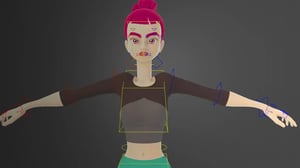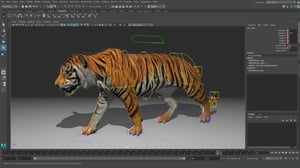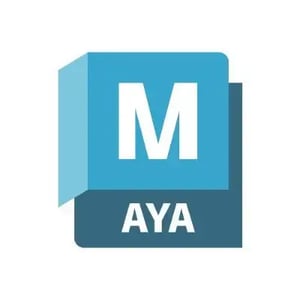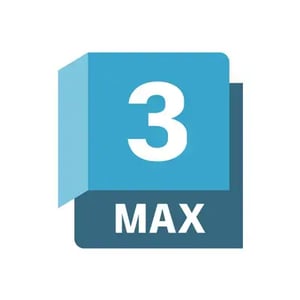
Character Rigger
The role, salary, software, and skills of a character rigger
TABLE OF CONTENTS
What does a character rigger do?
A character rigger generates the internal structural frameworks and controls of a 3D model, defining how an animator will be able to manipulate it. Their goal is to build a skeleton that will operate a character and bring it to life. Character and model riggers help to create believable movement that abides by the laws of anatomy, physics, and real-world experiences in a virtual environment. Character riggers can work in film, TV, and video games.
In video games, for example, an animated character must move fluidly for enhanced gameplay. Facial expressions, gait, and physical idiosyncrasies are important visual cues in animation. They create engagement and recognition with the player, which aids in connecting with a video game.
Character rigger job description
There are two main roles of a rigger: rigging and deformation. Rigging generates the 'bones' and controls of a 3D model and deformation is the process of making the points of the model. These points follow the rig/armature in a smooth and believable manner which determines the ways an animator will be able to manipulate it.
They work closely with 3D animators to help fix any bugs, intersections caused by the rig, or 'unnatural' movements.
Role & responsibilities of a character rigger in film and games:
- Creating joints and moving points to rotate and pivot
- Designing, testing, and maintaining character rig setups
- Ensuring character movements are fluid, free of glitches, and believable
- Writing MEL scripts to customize software to specific animation requirements
- Establishing logical system of file creation for use within the course of production
- Developing tools and plug-ins to optimize animation
- Facial rigs

How much does a character rigger make?
The average salary begins at around USD $63,000 for an entry-level job, whereas a lead character rigger can earn up to USD $113,000. (Source: Glassdoor). The role of the Character rigger is a specialized one. Some of the required skills can be learned in an 3D animation course or a virtual production course.
Skills required to become a character rigger
Character riggers must have good technical skills and an excellent understanding of human and animal anatomy.
Film and game studios may look for the following skills in character riggers:
- Familiarity with mechanics and movement of active forms
- Understanding of movement of limbs, the effect of weight, and the behavior of skin and flesh
- Basic understanding of animation to be able to test out their rigs
- Working knowledge of the laws of physics - Newton’s laws, gravity, acceleration and the laws of energy
- Strong skills in rigging tools and scripting languages
- Ability to create character gait, walk, and body language
What software and tools do character riggers use?
Character riggers will primarily work within a computer environment which requires knowledge of coding.
Character riggers may need knowledge of a combination of the following software:
- UNIX operating system
- MEL
- XSI
- C++
- Java
- Perl

Maya is a comprehensive 3D animation software used for creating detailed models, animations, and visual effects. It's popular in film, TV, and game development for its powerful tools.

3ds Max is a professional 3D computer graphics program for making 3D animations, models, games and images. It is developed and produced by Autodesk Media and Entertainment.

MotionBuilder is a 3D character animation software produced by Autodesk. It is used for virtual cinematography, motion capture, and traditional keyframe animation.
How to become a character rigger
Practice makes perfect. When you are first learning, it takes some time to get rigs and deformations operating as smoothly and realistically as possible.
Download different types of pre-rigged models (such as this free tiger rig) and see how they are put together. This will help teach you how to create skeletons for organic and mechanical assets.
Research is key. Prepare yourself for a career in this field by spending time gaining knowledge of:
- The motion of humans, bipedal creatures, quadruped creatures, and animals
- Facial movement and portraying different moods
- Mechanical design
- Mechanical operations
- Weight and physics
As technology improves, artists are expected to understand how motion capture works. Once the motion capture data is imported, animators will often have to tweak the keyframes to perfect the facial and body movements of the character.

Ready to Start Your Film & Games Journey?
Download our course guide to see how we can help you on your pathway to your dream career.Tips to break into the 3d animation industry
Spend as much time as you can on your best pieces of work. Pick a few and perfect them the best you can for your 3D portfolio or demo reel. Show versatility in the types of rigs you complete.
Use the networking opportunities available to animation artists to build up your contacts. This can be one of the best ways to get a job. Searching online, you can find many industry meetups and events, which often include guest speakers like professional artists and software creators. The knowledge gained by listening to these types of guest speakers talk about their personal experiences is irreplaceable.
Read more on creating an animation portfolio or demo reel that stands out or how to get 3D animation projects.

Industry Pathways
Mark Pullyblank, Department Head of 3D Animation at CG Spectrum, shares how he broke into the industry later in life, and what strategies he used to quickly move forward in his career. This episode is chock-full of actionable tips for artists starting out in the industry - don't miss it!


